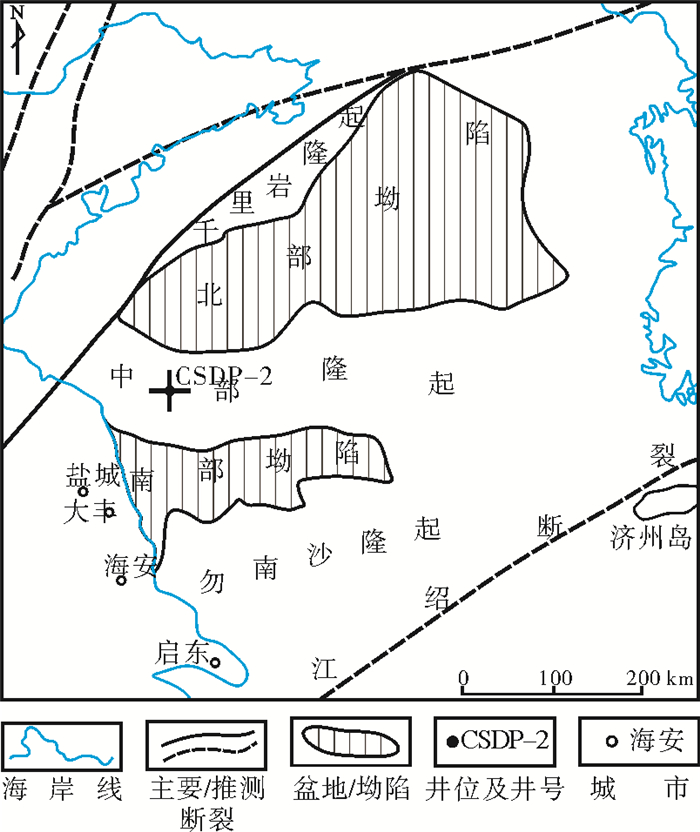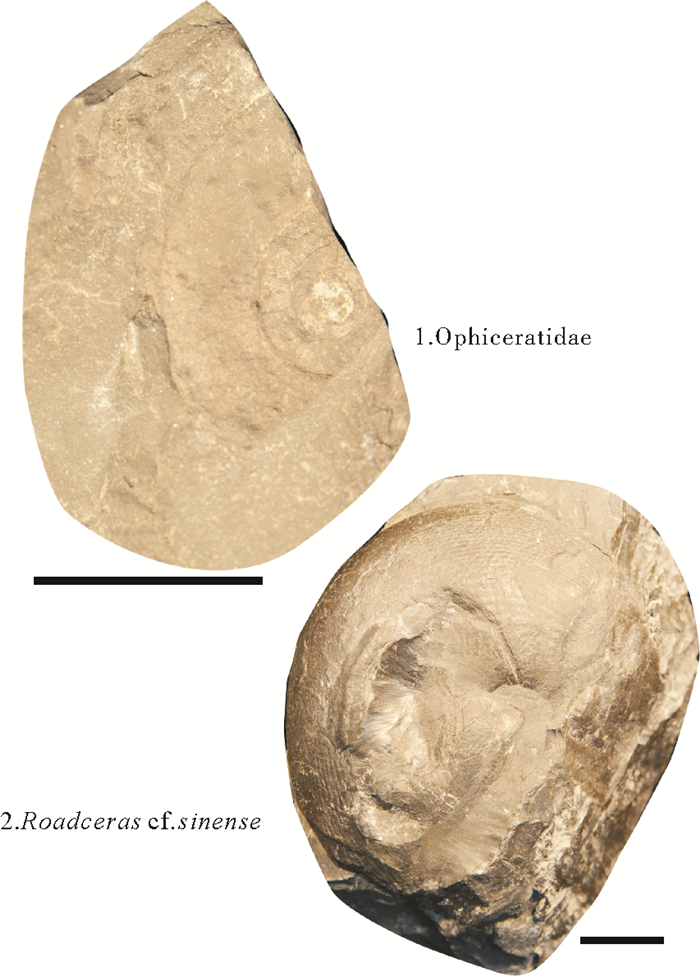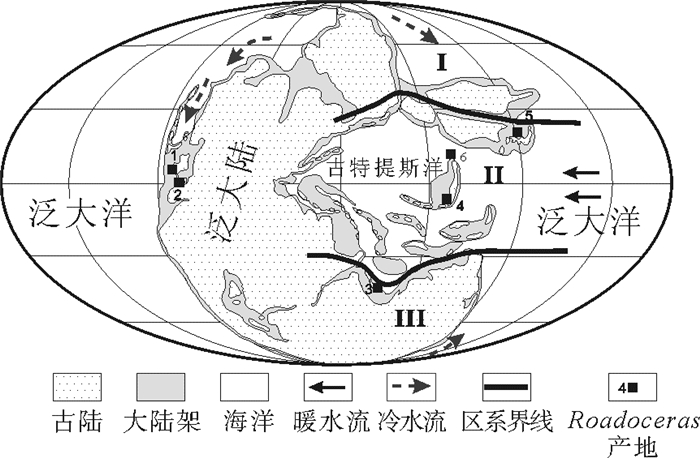DISCOVERY OF PERMIAN-TRIASSIC AMMONOIDS IN THE CENTRAL UPLIFT OF THE SOUTH YELLOW SEA AND ITS GEOLOGICAL IMPLICATIONS
-
摘要: 大陆架科学钻探CSDP-2井,是南黄海中部隆起上的唯一深钻,是揭示中-古生代海相地层时代,恢复沉积和构造环境的基准井。菊石是二叠纪至三叠纪的重要古生物,在指示地层时代和恢复古地理环境方面,都具有重要价值。在CSDP-2井岩心中发现多块菊石化石,其中的两块化石具有重要意义。根据菊石形态特征,取自1 475.2 m岩心中的Roadoceras cf. sinense 时代被鉴定为二叠纪罗德阶(Roadian)—吴家坪阶(Wuchiapingian),属于近20年来建立起来的菊石属Roadoceras,其古地理分布位于古赤道及双温区,此次发现的样品则来自华南北缘,拓展了该属的古地理分布范围。另外,在851.9 m处岩心中,发现了蛇菊石Ophiceratidae,其为早三叠世格里斯巴赫阶(Griesbachian)分子,非常接近三叠系的底部,为CSDP-2井二叠纪和三叠纪界线的划分提供了重要证据。上述菊石的发现,有助于厘定南黄海中部隆起二叠系-三叠系海相地层发育时代,恢复古地理环境,亦为南黄海进一步的沉积、构造和油气资源研究奠定重要基础。Abstract: The Borehole CSDP-2 of the Continental Shelf Drilling Program (CSDP) is the only deep hole ever drilled on the central uplift of the South Yellow Sea (SYS). As a reference well, it is critical important to the dating of marine Paleo-Mesozoic deposits and reconstruction of the paleo-environmental pattern and paleo-tectonic settings of the SYS region. Ammonites are recognized as excellent index fossils for approaching the above objectives. So far, many ammonite fossils have been found in the core of CSDP-2, of which two, namely Roadoceras cf. sinense and Ophiceratidae, are specifically significant. The fossil of Roadoceras cf. sinense was discovered at the depth of 1475.2 meters. It is an index fossil distributed from Late Roadian to Wuchiapingian temporally and in the palaeoequatorial and bi-temperate regions spatially. The new finding of Roadocerascf. sinense from CSDP-2 extended the distribution area of this genus to the further north. On the other hand, Ophiceratidae, which is found at a depth of 851.9 meters and belongs to Griesbachian, is very close to the bottom of Triassic, and valuable for study of Permian and Triassic boundary. The discovery of the ammonites is important for confirming the stratigraphic age of the Permian and Triassic marine formations on the central uplift of the SYS region, recovering the paleo - environmental pattern, and providing the foundation for the future study of sedimentation, tectonic and petroleum resources.
-
Keywords:
- South Yellow Sea /
- Continental Shelf Drilling Program /
- Ammonoid /
- Wuchiapingian /
- Griesbachian
-
南黄海中部隆起新近纪地层之下,为中-古生界海相沉积地层还是岩浆岩或者变质岩,一直以来都有不同意见[1],即使认为其为沉积地层的学者,也存在地层确切时代的争论[2]。此外,黄海作为我国唯一没有油气突破的海域,南黄海中-古生界油气,也被寄予厚望[3]。大陆架科学钻探CSDP-2井,是南黄海中部隆起的首钻,设计井深2 800 m,计划钻至下古生界,成为打开南黄海地层宝库的一把钥匙,将为后续的资源和环境研究奠定重要基础。
菊石作为指示地层时代和恢复沉积环境的重要标志古生物,会为地层时代划分和古地理恢复提供重要依据[4]。Leonova[5]详细讨论了二叠纪菊石生物地层研究的发展及现状后指出,二叠纪菊石,其产出的岩段定义了对应的阶或亚阶。相较于石炭纪菊石带得到广泛的应用,二叠纪菊石带的工作尚不完善,整个二叠纪可至多划出20个菊石带,尤其中二叠世还没有建立起完全满意的菊石带。上述问题导致了地层分辨率较粗糙,还有待于广大生物地层工作者继续努力,来解决这一科学问题。CSDP-2井中发现的二叠纪菊石化石,对完善二叠纪的菊石带将有积极作用,且系于CSDP-2井地理位置的独特性,将会更新对相关菊石存在的时空分布特征的认识。整个三叠纪尤其是在显生宙最大的生物灭绝事件-晚二叠世生物大绝灭之后,全球菊石动物群大量繁盛。因此,三叠纪地质及生物事件的时间框架对于解释地球及生命历史的一些独特事件显得尤为关键。三叠纪菊石时间表已发展及确立了将近两个世纪,尤其是早三叠世,以菊石带命名的阶:格里斯巴赫阶(Griesbachian),迪纳尔阶(Dienerian)、斯密斯阶(Smithian)和斯帕斯阶(Spathian)已得到了广泛应用。其中,前两个阶格里斯巴赫阶(Griesbachian)及迪纳尔阶(Dienerian)在国际地层表中对应于印度阶(Induan),以二叠纪-三叠纪大绝灭之后菊石的多样化及恢复为特征。因此,在三叠纪发现的菊石化石往往有较强的时代指示意义。
我国二叠系-三叠系分布广泛,该时期的海洋环境多样,既有地方性很强的局限海生态类型,又有全球性很强的开阔海生态类型[6]。而海洋环境长期保持不咸化,有利于菊石动物群的发育,可以反映出良好的生态分异。我国对于开阔海域菊石的系统研究开始于20世纪80年代,目前已经建立起可以与世界其他地区对比的生物带(周祖仁私人通讯)。而我国华南三叠纪海相地层以下三叠统为主,中三叠世之后大部分地区变为陆相。其中,早三叠世菊石生物地层研究在广西进展颇丰[7, 8],已经成为三叠系菊石生物地层研究的前沿地。大陆架科学钻探CSDP-2井,在钻至2 000 m井深过程中,在二叠系-三叠系岩心中获得多块菊石化石,其中两块具有重要的指示环境和划分地层的意义,本文将在详细描述其特征的基础上,解析其在全球的分布,恢复其生存环境,并阐述其地层指示意义。
1. 地质背景
南黄海盆地与苏北盆地同处下扬子块体,实为被海岸线所分隔的同一沉积盆地,海域范围为121°~124°E,面积约30×104 km2,盆内平均水深46 m,由西北向东南加深,最大水深可达106 m[9, 10],是在前寒武纪古老克拉通基础上发育的中、古生代海相与中、新生代陆相叠合盆地[11, 12]。自新元古代以来,南黄海盆地的沉积-构造演化可划分为稳定地台、克拉通盆地、断陷盆地、坳陷盆地4个阶段[13, 14],并自北向南依次分布“三隆两坳”5个构造单元,分别为千里岩隆起、北部坳陷、中部隆起、南部坳陷和勿南沙隆起[15, 16](图 1)。
大陆架科学钻探CSDP-2井是南黄海中部隆起的首钻,也是目前全球海洋科钻全取心最深井,成功揭示了南黄海中生代—古生代的地层。经岩心描述并结合江苏省岩石地层发育特征[17]初步分析认为,629 m井段之上为新近纪地层,629~860 m为三叠系青龙组,岩性主要为大套深灰色泥质灰岩和灰质泥岩;860~915 m为二叠系大隆组地层,主要发育灰色、深灰色粉砂岩、细砂岩,915~1 615 m为二叠系龙潭组,主要由黑色泥岩、灰色粉-细砂岩组成,夹煤线;1 615~1 621 m发育二叠系孤峰组硅质泥岩,1 621~1 691 m栖霞组灰黑色泥晶灰岩地层;1 691~1 902 m为石炭系船山组、黄龙组和高骊山组地层,岩性以灰色球粒状生物碎屑灰岩、肉红色泥晶灰岩和紫红色砾岩、粉砂质泥岩为主;底部自1 902 m后钻遇泥盆系五通群深灰色石英粉-细砂岩和灰色粉砂质泥岩地层,尚未见到五通群底部紫红色厚层石英砂砾岩(表 1)。
表 1 大陆架科学钻探CSDP-2井地层简表Table 1. Stratigraphic framework of borehole CSDP-2
2. 南黄海CSDP-2井1 475.2m岩心中发现的二叠系菊石
2.1 中国罗德菊石相似种Roadoceras cf. sinense的发现及其特征
罗德菊石Roadoceras由周祖仁[6](1985)基于Gastriocras roadense Böse建立而来。该属特征为壳呈半内卷至近内卷,饼状,脐部较小,U/D等于或小于0.3,但大于0.15。旋环增长强度中等,外缘呈宽顶的抛物线状。壳表饰有粗的丛旋纹与细的生长纹,个体发育晚期靠脐缘处纵旋纹可能消失;成年期无脐缘横肋。收缩沟见于发育早期,与生长纹一起在腹部形成较为宽深的腹弯。缝合线为简单的八叶式,腹叶从一般至较宽,两侧边近平行至向前略有扩张。目前,该属主要包括有:R. roadense,见于美国德克萨斯州Glass山的Word组,Altuda组,Hegler灰岩及Getaway灰岩[18],而在墨西哥,该种见于Coahuila西南的Valle de Las Delicias,其时代可能为卡匹敦阶(Capitanian)[18, 19];R. beedei,见于德克萨斯的Delaware山的Capitan层[19, 20];R. haacki,见于墨西哥Las Delicias的Timorites层与R. roadense同时代[19];R. prodromus见于俄罗斯Amur地区的Osakhtinskya组,与Waagenocerasobliqium共生[21, 22];而产于湖南的R. sinense及R. bellum则一直认为时代为茅口阶(Maokouan)的上部[23],对应于国际地层表的罗德阶(Roadian)上部-沃德阶(Wordian)。
周祖仁[23]建立了中国罗德菊石Roadocerassinense新种,壳内卷,呈厚的饼状,脐部小,U/D为0.17左右。腹部穹圆,两侧扁平,壳体最厚处位于脐缘附近,旋环横断面呈高的半圆形。脐部较深,脐缘呈圆角状,脐壁陡。壳表具有均匀的纵旋纹及细的生长纹,且纵旋纹在脐缘处略有缺失。发育早期偶见弱的收缩沟,与生长纹一起形成较深而圆的腹弯。缝合线腹叶宽,两侧边向前方扩展,腹中鞍与腹支叶均较宽,中鞍顶部略膨大,侧叶较短,基部较钝,脐叶宽浅,背叶和内侧叶尖而深。该种与R. roadense在外形、壳饰上很相似,但前者壳体较扁,脐部更小,缝合线腹叶、腹支叶均宽很多。
在CSDP-2井1 475.2 m处发现的菊石化石,壳形近内卷,整个壳面饰有纵旋纹,早期旋环未见横肋,发育晚期在脐缘处纵旋纹有消失的趋势。以上特征应归属于罗德菊石Roadoceras。本次发现的标本在壳形上与R. roadense及R. sinense相似,而作为区别两个种重要特征的缝合线,由于标本未见缝合线而难以区分,所以暂时定为Roadoceras cf. sinense。基于R. roadense时代为罗德阶(Roadian)-吴家坪阶(Wuchiapingian),R. sinense时代为吴家坪阶(Wuchiapingian),因此,标本时代定为罗德阶(Roadian)-吴家坪阶(Wuchiapingian)较为妥当(图 2)。
华南晚二叠世吴家坪阶(Wuchiapingian)菊石以地方性的安德生菊石科及阿拉斯菊石科占优势。另外有一些副腹菊石科中的属,此次发现的罗德菊石就是来自该科,此外还有极少数从早二叠世的3个科Maximitidae、Marathonitidae、Vidrioceratidae延续上来的后裔属。安德生菊石科及阿拉斯菊石科的菊石在形态上有如下共同特征:表面一般光滑;脐缘或多或少突出,甚至呈耳状;腹部多呈屋脊状或扁平状,且通常具腹中棱,显示了它们是适应泥质海底的环境生活的。
2.2 Roadoceras的古地理分布
Zhou[6]基于Gastrioceras roadense Böse的标本,首次建立了Roadocers属。湖南南部常宁产有:Roadocerasroadense (Böse),R.sinensis Zhou, R. bellum Zhou,Altudocerasaltudense (Böse),Doul-ingocerasnodosum Zhou和D. costituberosum,与之共生有乐平统腕足:Spinomarginiferalopingensis (Kayser),Edriostegespoyangensis (Kayser)及Transennatiagratiosa (Waagen)。产Roadoceras的层位之前认为其时代为晚卡匹敦阶(Capitanian)[6, 23],然而稍后的研究证明在湖南南部的Roadoceras - Doulingoceras带之下15 m灰岩中产出牙形Clarkinapostbitteri带[24, 25],后者位于乐平统最底部,并确定了瓜德鲁普统/乐平统界线GSSP[25, 26]。因此,Roadoceras- Doulingoceras 带在新的二叠系时代标准中被定为吴家坪阶(Wuchiapingian)[27, 28]。
另外, R. roadense (Böse)产于美国德克萨斯的Brewster县Glass山的Word组,Altuda组,Hegler灰岩及Getaway灰岩[18]。在墨西哥该种产自Coahuila西南的Valle de Las Delicias,共生有Waagenoceras和Timorites,时代可能为卡匹敦阶(Capitanian)[18, 19]。Roadocerasbeedei (Plummer and Scott)产自德克萨斯的Culberson县的Delaware山[19, 20]。R. haacki Miller产自墨西哥Las Delicias的Timorites带,与之共生的有R. roadense[19]。Roadocerasprodromus (Ruzhentsev)产自俄罗斯远东地区的阿穆尔地区(Bolshie Churki Range)的Osakhtinskya组的中部[21, 22],与之共生有Waagenocerasobliqium Ruzhentsev,在该组产出R. prodromus层位之上1.4 m发现了另外一块W. obliqium的标本,与Timoritessigillarium (Ruzhentsev)共生。Waagenocera s与Timorites,大多在卡匹敦阶(Capitanian)发现[19, 21, 22, 29, 30, 31];另外,Waagenoceras在广西来宾蓬莱滩剖面瓜德鲁普/乐平界线GSSP发现产自吴家坪阶(Wuchiapingian)牙形石Clarkinapostbitteripostbitteri带;而Timorites还有记录产自伊朗Araxoceras层的吴家坪阶(Wuchiapingian);并且,Timorites除了在伊朗和苏联各自的卓勒法地区和伊朗中部阿巴德地区与卓勒法阶局限海生态类型菊石群共生外,墨西哥考会拉地区La Colorada组[32],以及日本北上山地的Suenosaki组[33, 34],同样存在。墨西哥考会拉地区的La Colorada组中发现Timorites与Eoaraxoceras共生。而根据Ehiro等[34](1986)的报道,北上山地南部歌津地区(Utatsu)的Suenosaki组(Toyoma统下部)发现了Timoritesintermedium (Wanner)与Pseudogastrioceras sp.,Araxoceras cf. A. rotoides,Prototocerasjapanicum及Stacheocerasiwaizakiense共生。Roadocerassubroadense[34](Zakharov and Pavlov)与R. prodromus (Ruzhentsev)及R. roadense (Böse)相似,产于Barabash组下段,时代上可能是卡匹敦阶(Capitanian)。该段大约有200 m厚,特征是含有丰富的腕足:Anidanthusussuricus Fredericks,Liosotella cf. licharewiana Kotlyar,Waagenoconchakrystofovichi Fredericks,PetrospiriferalatiformisLicharew及Spiriferellalita (Fredericks)。该段之下产有有孔虫:Geinitzina sp.,Tetrataxis sp.,Pachiploides sp.及苔藓虫StenoporaclapaKiseleva。
古生物地理方面,Roadoceras在华南[6, 23]、藏南、俄罗斯远东地区[21, 35]及北美[19]等地区产出,主要位于北纬及南纬30°附近,赤道区仅在湖南省有发现,而此次该属在华南北缘的出现,说明了其在卡匹敦阶(Capitanian)-吴家坪阶(Wuchiapingian)时期具有较以前认识的更为广泛的分布(图 3)。
3. 南黄海CSDP-2井851.9m岩心中发现蛇菊石科Ophiceratidae
3.1 蛇菊石科Ophiceratidae分子的发现
蛇菊石科作为早三叠世的代表性化石,其典型的特征为壳旋环数目多,腹方穹圆,少数情况下变尖,有时脐壁很高。壳体外卷,蛇形旋转,呈盘状,旋环横断面为椭圆形。表面光滑或具有微弱的横肋。缝合线为齿菊石式,叶的下端有细齿,具有两个侧叶,存在于早-中三叠世。在大陆架科学钻探CSDP-2井851.9 m岩心中发现菊石标本极其外卷,从已有的旋环来看其数目可达到5个,显示了蛇菊石科Ophiceratidae的特征,但由于脐部、腹部特征不明,缝合线未保存,且无任何壳饰,确切属名无法确定(图 2)。
3.2 蛇菊石科Ophiceratidae分子的时代意义
早三叠世自下而上包括两个阶—印度阶(Induan)、奥伦尼克阶(Olenekian),为Kiparisova和Popov [37, 38]基于印度-巴基斯坦及西伯利亚东北菊石动物群定义而来。菊石研究者则习惯于依据菊石动物群的发育特征将印度阶(Induan)自下而上对应为格里斯巴赫阶(Griesbachian)和迪纳尔阶(Dienerian),奥伦尼克阶(Olenekian)则对应于斯密斯阶(Smithian)和斯帕斯阶(Spathian)。需要注意的是虽然迄今为止已经提出了不少的早三叠世菊石的生物区[39, 40, 41],而且早三叠世菊石生物区系变化十分明显[42],格里斯巴赫阶(Griesbachian)-迪纳尔阶(Dienerian)这一时段菊石的整个面貌是以广泛分布世界种为特征,而到了斯密斯阶(Smithian)和斯帕斯阶(Spathian),却是迅速转变为以地方性种广布和纬度限制为特征[40]。
传统上认为,格里斯巴赫阶(Griesbachian)的底部以耳菊石Otoceras 的首现为标志,该属在特提斯及北方区均有发现。Otoceras的首现长时间被认为是三叠纪的底部[43, 44],但是现在达到广泛共识的牙形石Hindeodusparvus确立为印度阶(Induan)的底部的标志种,导致Otoceras 归为晚二叠世[45, 46]。实际上,格里斯巴赫阶(Griesbachian)底部位于三叠纪的岩性地层的内部,靠近蛇菊石Ophiceras的首现,该界线上即格里斯巴赫阶(Griesbachian)底部菊石发生了重大的生物事件-出现了大量蛇菊石科分子。因此,在CSDP-2井中出现蛇菊石Ophicera-tidae,即可认为其下部即为二叠纪和三叠纪的界线。
4. 结论
(1) 在大陆架科学钻探CSDP-2井岩心中,采获罗德阶(Roadian)-吴家坪阶(Wuchiapingian)的Roadoceras cf. sinense,及早三叠世格里斯巴赫阶(Griesbachian)蛇菊石科Ophiceratidae分子。
(2) 在大陆架科学钻探CSDP-2井1 475.2 m处发现的菊石化石,为Roadoceras cf. sinense,属于菊石Roadoceras属,其古地理分布位于古赤道及双温区,而此次发现将它的分布范围扩大到了华南北缘。
(3) 在大陆架科学钻探CSDP-2井中发现的菊石化石,为蛇菊石科Ophiceratidae,该科在格里斯巴赫阶(Griesbachian)较为繁盛,其出现被视为早三叠纪的重大生物事件,且在全球有着广泛的分布,可用作重要的标准化石,该发现使得CSDP-2井中三叠系和二叠系的界线更加明朗。
(4) 上述菊石化石的发现,对南黄海中部隆起二叠系-三叠系海相地层发育的时代和古地理环境研究具有重要意义,将为南黄海进一步的沉积、构造和油气资源研究奠定重要基础。
-
表 1 大陆架科学钻探CSDP-2井地层简表
Table 1 Stratigraphic framework of borehole CSDP-2

-
[1] 姚永坚, 冯志强, 郝天珧, 等.对南黄海盆地构造层特征及含油气性的新认识[J].地学前缘, 2008, 15(6): 232-240. doi: 10.3321/j.issn:1005-2321.2008.06.030 YAO Yongjian, FENG Zhiqiang, HAO Tianyao, et al. A new understanding of the structural layers in the South Yellow Sea Basin and their hydrocarbon-bearing characteristics[J]. Earth Science Frontiers, 2008, 15(6): 232-240. doi: 10.3321/j.issn:1005-2321.2008.06.030
[2] 祁江豪, 温珍河, 张训华, 等.南黄海地区与上扬子地区海相中—古生界岩性地层对比[J].海洋地质与第四纪地质, 2013, 33(1): 109-119. QI Jianghao, WEN Zhenhe, ZHANG Xunhua, et al. Lithostratigraphic correlation of Mesozoic and Palaeozoic Marine strata between South Yellow Sea and Upper Yangtze Region[J]. Marine Geology and Quaternary Geology, 2013, 33(1): 109-119.
[3] 刘光鼎.中国油气资源企盼二次创业[J].地球物理学进展, 2001, 16(4): 1-3. doi: 10.3969/j.issn.1004-2903.2001.04.001 LIU Guangding. The second exploitation of the oil and gas resources in China[J]. Progress in Geophysics, 2001, 16(4): 1-3. doi: 10.3969/j.issn.1004-2903.2001.04.001
[4] 牟林.中国下、中二叠统界线附近菊石生物群及其生物地层意义[J].古生物学报, 2011, 50(4): 439-449. http://www.wanfangdata.com.cn/details/detail.do?_type=perio&id=gswxb201104003 MU Lin. Ammonoid Faunas around the Early and Middle Permian boundary in china and their biostratigraphic implications[J]. Acta Palaeontologica Sinica, 2011, 50(4): 439-449. http://www.wanfangdata.com.cn/details/detail.do?_type=perio&id=gswxb201104003
[5] Leonova T B. Permian ammonoids: biostratigraphic, biogeographical, and ecological analysis[J]. Paleontological Journal, 2011, 45(10): 1206-1312. doi: 10.1134/S0031030111100029
[6] Zhou Z R. Several problems on the Early Permian ammonoids from South China[J]. Palaeontologia Cathayana, 1985(2): 179-210. http://ir.nigpas.ac.cn/handle/332004/5878
[7] Chao J. Lower Triassic Ammonoids from Western Kwangsi, China[M]. Beijing: Science Press, 1959.
[8] Brayard A, Bucher H. Smithian (Early Triassic) ammonoid faunas from northwestern Guangxi (South China): taxonomy and biochronology[J]. Fossils and Strata, 2008, 55: 1-179. http://d.old.wanfangdata.com.cn/NSTLQK/NSTL_QKJJ0214759408/
[9] 胡芬, 江东辉, 周兴海.南黄海盆地中、古生界油气地质条件研究[J].海洋石油, 2012, 32(2): 9-15. doi: 10.3969/j.issn.1008-2336.2012.02.009 HU Fen, JIANG Donghui, ZHOU Xinghai. Study on the petroleum geologic conditions in Mesozoic-Paleozoic Strata in the South Yellow Sea basin[J]. Offshore Oil, 2012, 32(2): 9-15. doi: 10.3969/j.issn.1008-2336.2012.02.009
[10] 杨艳秋, 李刚, 易春燕.南黄海盆地海相地层地震反射特征及地震层序地质时代[J].东北石油大学学报, 2015, 39(3): 50-59, 124. doi: 10.3969/j.issn.2095-4107.2015.03.007 YANG Yanqiu, LI Gang, YI Chunyan. Characteristics of seismic reflection and geological ages of seismic sequences for marine strata in the South Yellow Sea basin[J]. Journal of Northeast Petroleum University, 2015, 39(3): 50-59, 124. doi: 10.3969/j.issn.2095-4107.2015.03.007
[11] 杨长清, 董贺平, 李刚.南黄海盆地中部隆起的形成与演化[J].海洋地质前沿, 2014, 30(7): 17-21, 33. http://d.old.wanfangdata.com.cn/Periodical/hydzdt201407003 YANG Changqing, DONG Heping, LI Gang. Formation and tectonic evolution of the Central Uplift of the South Yellow Sea basin[J]. Marine Geology Frontiers, 2014, 30(7): 17-21, 33. http://d.old.wanfangdata.com.cn/Periodical/hydzdt201407003
[12] 张训华, 杨金玉, 李刚, 等.南黄海盆地基底及海相中、古生界地层分布特征[J].地球物理学报, 2014, 57(12): 4041-4051. doi: 10.6038/cjg20141216 ZHANG Xunhua, YANG Jinyu, LI Gang, et al. Basement structure and distribution of Mesozoic-Paleozoic marine strata in the South Yellow Sea basin[J]. Chinese Journal of Geophysics, 2014, 57(12): 4041-4051. doi: 10.6038/cjg20141216
[13] 侯方辉, 田振兴, 张训华, 等.南黄海盆地两条地震剖面的重磁数据联合反演效果[J].石油地球物理勘探, 2012, 47(5): 808-814. http://www.ogp-cn.com.cn/CN/article/searchArticle.do HOU Fanghui, TIAN Zhenxing, ZHANG Xunhua, et al. Joint inversion of gravity, magnetic and seismic data of the South Yellow Sea basin[J]. Oil Geophysical Prospecting, 2012, 47(5): 808-814. http://www.ogp-cn.com.cn/CN/article/searchArticle.do
[14] 李强, 温珍河.南黄海盆地成因机制及其构造意义[J].海洋地质前沿, 2014, 30(10): 14-17. http://d.old.wanfangdata.com.cn/Periodical/hydzdt201410003 LI Qiang, WEN Zhenhe. Origin of the South Yellow Sea basin and its tectonic implication[J]. Marine Geology Frontiers, 2014, 30(10): 14-17. http://d.old.wanfangdata.com.cn/Periodical/hydzdt201410003
[15] 冯志强, 陈春峰, 姚永坚, 等.南黄海北部前陆盆地的构造演化与油气突破[J].地学前缘, 2008, 15(6): 219-231. doi: 10.3321/j.issn:1005-2321.2008.06.029 FENG Zhiqiang, CHEN Chunfeng, YAO Yongjian, et al. Tectonic evolution and exploration target of the northern foreland basin of the South Yellow Sea[J]. Earth Science Frontiers, 2008, 15(6): 219-231. doi: 10.3321/j.issn:1005-2321.2008.06.029
[16] 高顺莉, 谭思哲, 侯凯文, 等.南黄海海域侏罗系分布与构造意义[J].海洋地质前沿, 2015, 31(4): 7-12. doi: 10.16028/j.1009-2722.2015.04002 GAO Shunli, TAN Sizhe, HOU Kaiwen, et al. Distribution pattern of the Jurassic in the South Yellow Sea and its tectonic implications[J]. Marine Geology Frontiers, 2015, 31(4): 7-12. doi: 10.16028/j.1009-2722.2015.04002
[17] 徐学思.江苏省岩石地层[M].北京:中国地质大学出版社, 1997. XU Xuesi. Stratigraphy (Lithostratic) of Jiangsu Province[M]. Beijing: China University of Geosciences Press, 1997.
[18] B?se E. The Permo-Carboniferous ammonoids of the Glass Mountains, West Texas, and their stratigraphic significance[J]. University of Texas Bulletin, 1917, 1762(5): 1-241. doi: 10.1086/622647
[19] Miller A K, Furnish W M. Permian ammonoids of the Guadalupe Mountain region and adjacent areas[J]. GSA Special Papers, 1940, 26: 1-238.
[20] Plummer F B, Scott G. Upper Paleozoic ammonites in Texas[J]. The Geology of Texas Bulletin of Texas University, 1937, 3701(3): 1-516.
[21] Ruzhencev V E. Late Permian ammonoids in the Russian Far East[J]. Palaeontology Zhurnal, 1976, 3: 36-50.
[22] Kotlyar G V, Zahkarov Y D, Popeko L L, et al. Layers with Timorites in East Asia[J]. Geology of the Pacific Ocean, 1999, 14: 361-380.
[23] Zhou Z R. Early Permian ammonite fauna from southeastern Hunan[C]//Collections of Postgraduate Theses. Nanjing: Jiangsu Science and Technology Publisher, 1987: 285-348.
[24] Mei S L, Jin Y G, Wardlaw B R. Conodont succession of the Guadalupian-Lopingian Boundary strata in Laibin of Guangxi, China and west Texas, USA[J]. Palaeoworld, 1998, 9: 53-76.
[25] Henderson C M, Mei S L, Wardlaw B R. New conodont definitions at the Guadalupian-Lopingian boundary[C]//Hills L V, Henderson C M, Bamber E W. Carboniferous and Permian of the World. Canadian Society of Petroleum Geologist Memoir, 2002, 19: 725-735.
[26] Jin Y G, Henderson C M, Wardlaw B R, et al. Proposal for the global stratotype section and point (GSSP) for the Guadalupian-Lopingian boundary[J]. Permophiles, 2001, 39: 32-42.
[27] Jin Y G, Wardlaw B R, Glenister B F, et al. Permian chronostratigraphic subdivisions[J]. Episodes, 1997, 20(1): 10-15. doi: 10.18814/epiiugs/1997/v20i1/003
[28] Jin Y G, Shang Q H, Wang X D, et al. Chronostratigraphic subdivision and correlation of the Permian in China[J]. Acta Geologica Sinica, 1999, 73(2): 127-138. doi: 10.1111/j.1755-6724.1999.tb00820.x
[29] Haniel C A. Die Cephalopoden der Days von Timor[M]//Wanner J. Paläontologie von Timor. Stuttgart: E. Schweizerbart'sche Verlagsbuchhandlung, 1915: 1-153.
[30] Liang X L. New material of Permian ammonoids with discussion on the origin, migration of Araxoceratidae and the horizon of the Paratirolites[J]. Acta Palaeontologica Sinica, 1983, 22(6): 606-615.
[31] Ehiro M. Ammonoid biostratigraphy of the Middle Permian in the South Kitakami Belt, Japan, and correlation with the reference sections in the Tethyan region and North America[J]. Proceedings of the Royal Society of Victoria, 1998, 110(1-2): 147-156.
[32] Spinosa C, Furnish W M, Glenister B F. Araxoceratidae, Upper Permian ammonoids, from the Western Hemisphere[J]. Journal of Paleontology, 1970, 44(4): 730-736. doi: 10.2307/1302664
[33] Hayasaka I. Younger Paleozoic cephalopods from the Kitakami Mountains, Japan[J]. Journal of the Faculty of Science, Hokkaido University, 1954, 8(4): 361-374.
[34] Ehiro M, Shimoyama D, Murata M. Some Permian cyclolobacear from the Southern Kitakami Massif, Northeast Japan[J]. Transactions and Proceedings of the Palaeontological Society of Japan New, 1986, 142.
[35] Zakharov Y D, Pavlov A M. Permskie cephalopody Primorya I problema zonalnogo raschleneniya Permi Teticheskoj obasti (Permian cephalopods of Primorye region and the problem of Permian zonal stratigraphy in Tethys)[M]//Zakharov Y D, Onoperienko Y I. Korrelyatsiya Permo-Triasovykh otlozhenij vostoka SSSR (Correlation of Permo-Triasssic sediments of East USSR). Acad. Vladivostok: Naulk SSSR Dalneostachnyi Nauchnyi Tscentr, 1986: 5-32.
[36] Shen S Z, Mu L, Zakharov Y D. Roadoceras (Permian Ammonoidea) from the Qubuerga Formation in the Mt. Everest Area in Southern Tibet[J]. Gondwana Research, 2004, 7(3): 863-869. doi: 10.1016/S1342-937X(05)71070-4
[37] Kiparisova L D, Popov Y N. Subdivision of the Lower series of the Triassic System into stages[J]. Doklady Akademiya Nauk USSR Seriya Geologicheskaya, 1956, 109(4): 842-845.
[38] Kiparisova L D, Popov Y N. The project of subdivision of the Lower Triassic into stages[C]//XXII International Geological Congress, Reports of Soviet Geologists. 1964, 16: 91-99.
[39] Diener C. Die marinen Reiche der Triasperiode[J]. Denkschriften der Kaiserlichen Akademie der Wissenschaften, Mathematisch-naturwissenschaftliche Klasse, 1916, 92: 405-549.
[40] Tozer E T. Triassic Ammonoidea: classification, evolution and relationship with Permian and Jurassic forms[M]//House M R, Senior J R. The Ammonoidea. Systematics Association Special. London: Academic Press, 1981, 18: 66-100.
[41] Dagys A S. Major features of the geographic differentiation of Triassic ammonoids[M]//Wiedmann J, Kullmann J. Cephalopods present and past. E. Stuttgart: Schweizerbart'sche Verlagshandlung, 1988: 341-349.
[42] Brayard A, Escarguel G, Bucher H. The biogeography of Early Triassic ammonoid faunas: clusters, gradients, and networks[J]. Geobios, 2007, 40(6): 749-765. doi: 10.1016/j.geobios.2007.06.002
[43] Griesbach C L. Paleontological notes on the Lower Trias of the Himalayas[J]. Records of the Geological Survey of India, 1880, 13: 94-113.
[44] Mojsisovics E, Waagen W H, Diener C. Entwurf einer Gliederung der pelagischen Sediments des Trias-Systems[J]. Sitzungsberichte Akademie Wissenschaft Wien, Mathematische-naturwissenschaftliche Klasse, 1985, 104: 1271-1302.
[45] Orchard M J, Tozer E T. Triassic conodont biochronology and intercalibration with the Canadian ammonoid sequence[J]. Albertiana, 1998, 20: 33-44.
[46] Orchard M J, Tozer E T. Triassic conodont biochronology, its intercalibration with the ammonoid standard, and a biostratigraphic summary for the western Canada sedimentary basin[J]. Canadian Society of Petroleum Geologists Bulletin, 1997, 45(4): 675-692.
-
期刊类型引用(2)
1. 张兰,何贤科,段冬平,程俊阳,陈晨,汪文基. 西湖凹陷平西地区古沟谷内隐蔽油气藏潜力. 海洋地质前沿. 2022(01): 41-50 .  百度学术
百度学术
2. 刘英辉,蔡华,段冬平,荣乘锐,常吟善,徐清海. 西湖凹陷平湖地区平湖组海侵体系域潮控三角洲-潮坪沉积特征及模式. 海洋地质前沿. 2022(01): 33-40 .  百度学术
百度学术
其他类型引用(1)




 下载:
下载:




